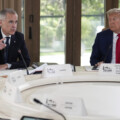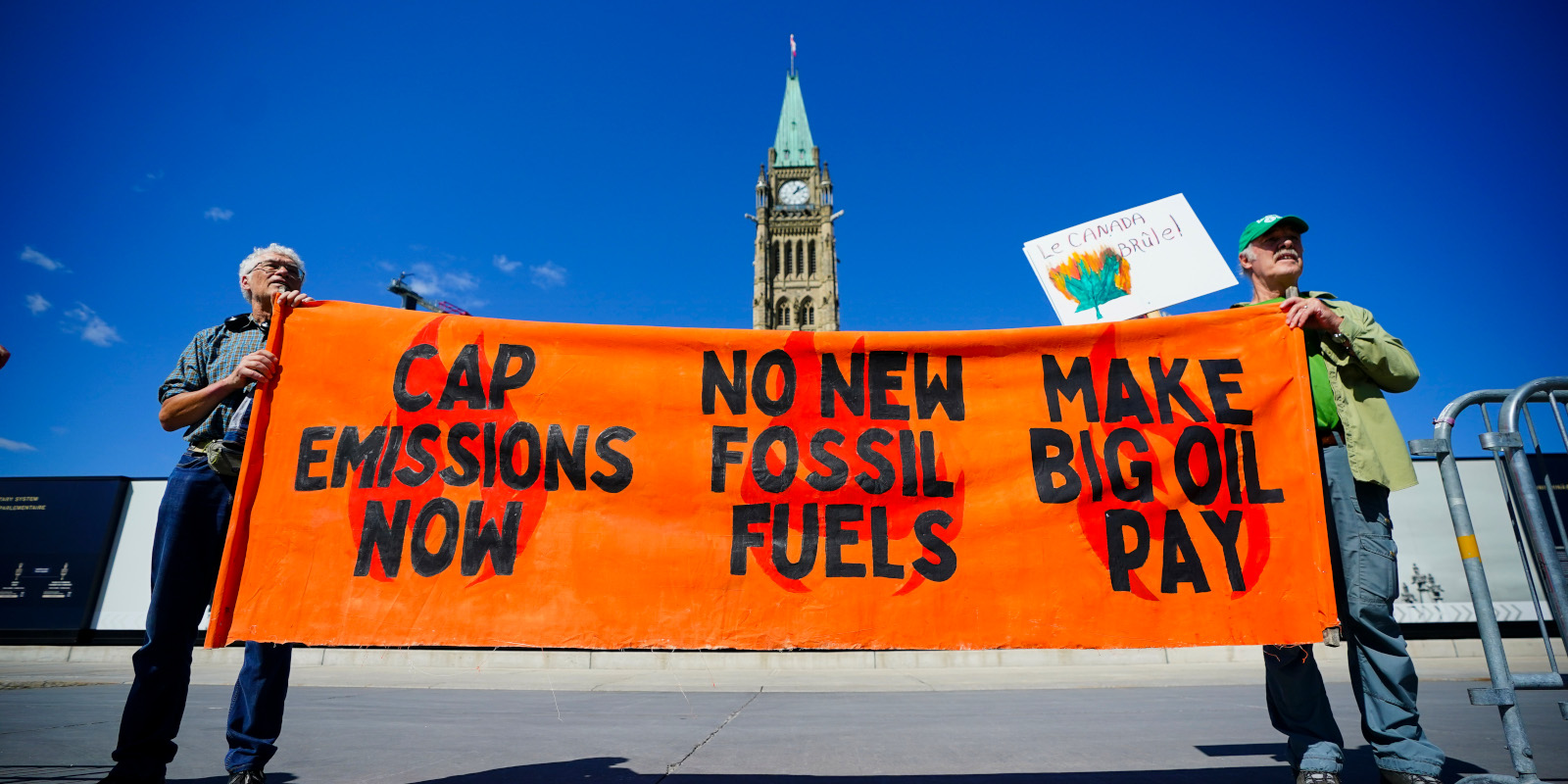As the world meets in Dubai for the COP28 climate conference, it’s become increasingly unclear if Canada will be able to achieve its own emission reduction targets. The national consensus around the carbon tax, once declared the winner of the 2019 federal election by the CBC, is collapsing.
A majority of Canadians now oppose carbon tax increases, and a slim majority have concluded the tax is ineffective at combating climate change (this appears to be a counterfactual conclusion, but the voter is always right). Canadians don’t want to give up: a large majority are concerned about climate change and wish the government was doing more. They just don’t want to pay for those efforts. Climate is a looming concern, but rent is an immediate one.
To address that concern, the Government of Canada is aiming to reduce national emissions by 40 to 45 percent below 2005 levels by 2030, and put us on a path to achieve net-zero emissions by 2050. The carbon tax—including the consumer and industrial components—is estimated to represent approximately one-third of those projected reductions, making it a large part of the strategy.
Pierre Poilievre, however, has made scrapping the carbon tax a key policy plank. That didn’t work for Andrew Scheer in 2019; two-thirds of voters backed a party that endorsed a tax, suggesting Canadians saw it as necessary to combat climate change. Today though, as cost of living concerns dominate politics, any policy with “tax” in the name will be a difficult sell. The carbon tax’s impact on liveability does appear to be minimal, and many Canadians receive the climate action incentive payment. But the tax is a visible contributor to gas bills, while the Climate Action Incentive Payment is an obscure line in the depths of your chequing account.
Those nuances have been lost in the government’s oft-dire communication strategy, and all this confusion has consequences. After Ottawa recently announced a carbon tax exemption for oil-heated homes in Atlantic provinces, Scott Moe declared Saskatchewan would stop collecting the tax unless it also received exemptions. Danielle Smith has mulled challenging the exemptions in court. An unpopular, uneven tax is unlikely to be a winning issue in the next election, leaving the carbon tax to risk death by a thousand grumblings.
Whatever your thoughts on the carbon tax, it’s not difficult to imagine a future where it’s gutted or axed. How can Canada make up for it? Will Poilievre or Justin Trudeau have the political will to implement policies that make Canada’s attendance at COP more than ceremonial? And are there any ideas that could avoid politicization in today’s, well, climate?
Dale Beugin, the executive vice president of the Canadian Climate Institute, tells The Hub that Trudeau’s recent carveouts will have little effect on emissions. But any policy that’s sporadically applied raises questions about how much the government really believes in its own ideas.
“Exceptions undermine signalling, and could have bigger ramifications,” Beugin says. “From a policy perspective, it’s creating perceptions that policy might change again in the future. That’s really bad for attracting investment for low-carbon technologies, it’s really bad for emissions reductions. Long-term policy certainty is critical to doing what the policy is supposed to do.”
Beugin was quick to point out that a carbon tax is only the most visible tool in a robust toolbox of regulations, subsidies, and pricing schemes. The output-based pricing system (OBPS) for industrial emitters continues to function without political drama, and Beugin highlighted oil and gas methane regulation as a winning program; the government gets fewer emissions of a powerful greenhouse gas, and the industry avoids leaky pipes and lost profits. But if the carbon tax dies, we’ll need much bigger ideas.
A rejection of the carbon tax is not an inherent rejection of climate policy. Debate, Beugin says, is “healthy,” as long as we’re debating between sincere policy options. But having “some kind of sound policy is starting to become a minimum requirement.” The 2019 election was about far more than the carbon tax, but it was notable that Scheer’s plan would have left Canada far from its emissions reduction target. That approach is unlikely to be viable again, electorally or existentially.
“It doesn’t seem like there’s a world in which we don’t have strong climate policy,” Beugin says. “We’re seeing the impact of climate change with forest fires and floods, it’s increasingly present in Canadians’ lives. Climate impacts could be worth half a year of GDP growth in 2025. And it’s increasingly obvious the world is moving. Canada’s ability to attract international investment is starting to be affected by climate policy.”
Beugin points to the fact that investment decisions are now pivoting around the availability of cheap, clean, low-carbon electricity. LG Chem spurned Ontario out of concern this would be lacking, while an Alberta solar farm drew Amazon to the province. Clean electricity attracts capital, which Beugin notes “isn’t going to happen without some policy signals.” Climate policy, then, could be presented as a job creator, not as a purse-pinching burden.
“It increasingly feels like the engine that’s driving climate policy is not just abstract targets, but growth and competitiveness,” Beugin says. “More and more, the key factor that drives good climate policy is the idea that you can’t lag too far behind the world, or you’re not going to be able to compete.”
More clean electricity would also allow Canada’s EV charging network to scale up and make electric vehicles more desirable. And, with the country in desperate need of more housing stock, there’s an opportunity to build a wave of low-emission homes. But if the carbon tax goes, industry will likely have to pick up the slack.
“The OBPS is a real opportunity,” Beugin says. “It cuts on both edges, it drives emission reductions because it sets expectations about industrial carbon price, and it protects the competitiveness of high-emission steel, cement, and aluminum producers because it ensures they have incentives to reduce emissions by improving performance, not shipping production elsewhere. Low carbon projects that reduce emissions can generate credits worth cash.”
The carbon tax has been a political nightmare because it has visible costs and obscure benefits. Regulatory policies aren’t invisible, but they can be market-friendly. “You’re requiring emitters to do something they wouldn’t have otherwise done,” Beugin says. “That may be easier and more amenable to conservatives if there are market-based mechanisms backed in; if you have compliance flexibility, ways to avoid doing the most expensive things while still having incentive to do the cheap things. If we assume the OBPS is robust and stable, that’s a good way to cover a big chunk of emissions in a way that doesn’t undermine competitiveness.”
Then there is adaptation, which Beugin calls the “poor cousin” of climate mitigation. This, essentially, is future-proofing, from hardening infrastructure against floods to adjusting agricultural practices for extreme weather to modernising financial regulations so the climate risks of projects are disclosed; no one wants to invest in real estate built on a floodplain. “There’s a lot to do there,” Beugin says. “Canada has started down that road, it has a broad framework, but there’s a ton of work to be done in starting to send those signals to adapt. That’s still growing, and it’s not very partisan.”

However Canada chooses to move forward, our policy signals need to be clear and consistent, not riddled with headline-dominating exceptions. By this time next year, it’s possible the United States will be on the verge of abruptly reversing its climate policy. If Canada is to stay prepared and competitive, we cannot afford such slip-ups.
The thing that’s most painful for industry and investments is wild oscillations,” Beugin says. “They would much rather have some certainty. There may be a strong case, even if the U.S. falls on its face again, for moving steadily and with certainty in the Canadian markets.”
Beugin sees a path forward to net zero. Climate Institute modelling says Canada can hit at least two-thirds of its 2030 targets with safe bets technologies; clean energy, electric vehicles, and other technologies with few variables. Wildcard technologies that may or may not pan out, like extracting CO2 with direct air capture, should contribute two-thirds by 2050. “To deploy safe bets, we need steady, incremental policy like regulations or output-based carbon pricing,” Beugin says. “Wildcards can be driven by incentives for innovation. Canada really needs policy for both.”
The hard reality of climate change, Beugin says, lies between denying its existence and worrying that it’s already too late to act. Federal policy needs to be genuine, broad, stringent, and consistent, not mercurial and optics-driven. And provinces need to get in the game instead of griping from the sidelines.
“What’s been interesting, and maybe problematic, is that it’s really been the federal government driving climate policy,” Beugin says. “But the provinces have a role to play, especially on things like buildings and electricity. So there’s an opportunity there for provinces to send some signals to electricity regulators and utilities to really start to scale up that clean electricity. That could make a huge difference.”
As attractive as the image of Canadians putting aside their differences for the sake of survival may be, it’s economics that could finally unite even the staunchest political opponents. Every voter wants jobs, and every party wants to be seen making them. COP summits may be dogged by criticism, but their very existence is a sign the low-carbon economy is coming. A drive to compete in it could become Canada’s new climate consensus, as long as our policy is more than mere theatre.
“A black-and-white conversation around doing nothing or doing everything is not stable because of the trends we’re seeing in markets and the acceleration of climate impacts,” Beugin says. “There are near-term benefits to competing in this low-carbon global economy. The competition for capital is starting to get pretty fierce. That is imminent and short-term and urgent.”
Recommended for You

‘There are consequences to this legislation’: Michael Geist on why the Canada-U.S. digital services tax dustup was a long time coming

Rudyard Griffiths and Sean Speer: The future of news in Canada: A call for rethinking public subsidies

‘You have to meet bullying with counter-bullying’: David Frum on how Canada can push back against Trump’s trade negotiation tactics

‘Our role is to ask uncomfortable questions’: The Full Press on why transgender issues are the third rail of Canadian journalism



